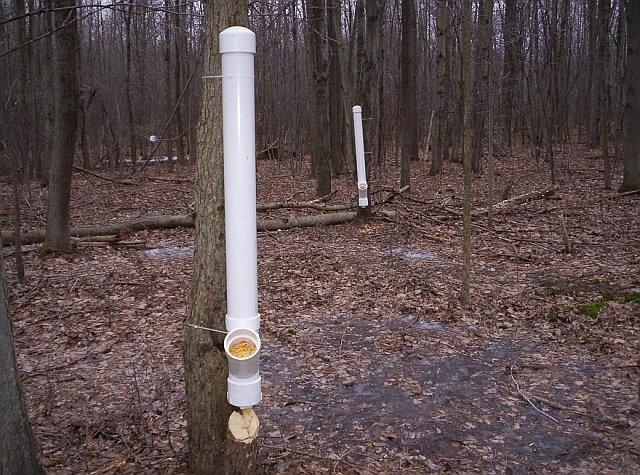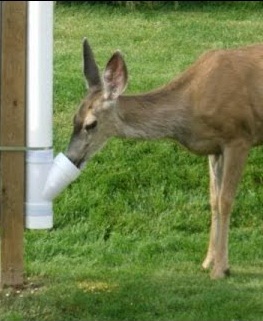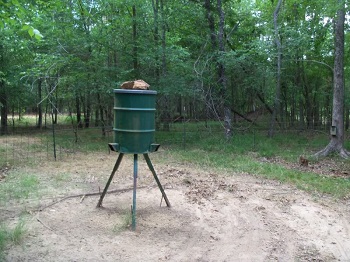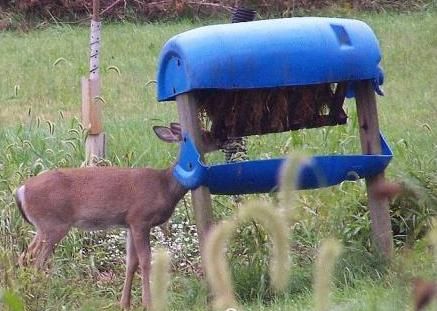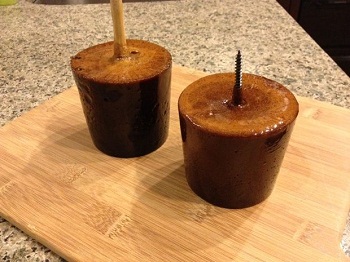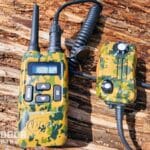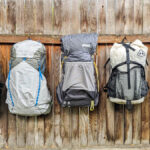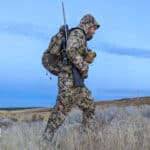Hunting is a hobby that involves a lot of dedication, knowledge, hard work and luck. One thing that is constant with every hunter out there is that they are always searching for ways to improve their chances of harvesting an animal.
Using a deer feeder is one method that many hunters use to achieve better opportunities for a successful hunt. There are different styles to choose from — some are attached to a tree trunk, hanged from a tree or mechanism, and some are standing with their legs.
Cost Cutting
Hunting is an expensive hobby that requires a lot of equipment including your weapon, apparel, optics and other devices that aid in taking a perfect and ethical shot. So when it comes to cutting corners on expenses, many hunters are willing to explore their options.
Deer feeders can be expensive so many hunters look for ways to build their own. Here are the different styles of homemade deer feeders and an overview of how to construct them.
Popular Homemade Game Feeder Styles
Trough Table
One of the most shared and primary deer feeders that you can replicate is a channel table style. To accomplish this simple task, you need to make a table with deep edges to keep the corn or grain from falling out.
Pros
- It allows the deer to approach the table and see all around them as they eat. Some deer may be discouraged if part of their view is blocked while they eat.
Cons
- You have to refill it continually which can become cumbersome and possibly expensive depending on how far you intend to travel.
- It is exposed to all weather conditions and varmints.
How to Overcome the Downside
Using the same table setup, add a container (can be made of wood, plastic buckets, barrels, or anything else that you have access to) that has holes on the sides near the bottom. Then place in the center of the table.
This allows you to fill up the container and tray with the corn or grain. As the tray is emptied, the container uses gravity to fill up the plate. Your visits to refill it are now spaced out.
However, the feeder is still exposed to the elements so you have to build a shelter over it. Depending on how extensive the roof is would determine how much weather is kept off the feed and table.
And like any deer feeder, once you’ve built it you need to consider where to place your feeder. Pick a good spot to make sure it’s effective.
Gravity Feeder
Another basic feeder is a mounted game feeder. There are different styles to this as well, and much of it depends on what materials are used, not to mention your skill level and what tools you have.
Like some popular commercially available deer feeders, these use gravity to keep a limited amount of food accessible at a time. Though these won’t give you quite as much control over how much feed is distributed as an automated feeder would.
PVC Pipe
The most famous is built from a long wide tube of PVC pipe with a cap on the top. At the bottom, place a 90-degree elbow and then a 45-degree angle pointing up — forming a “J” shape.
This will allow you to fill up the tube and the grain won’t fall out directly. The deer will be able to eat from the 45-degree angle piece. As they eat, gravity will refill the base with grains.
“Y” Shape
Other variations of the PVC pipe style gravity feeders only change at the bottom. For some, they use a 45-degree “Y” attachment piece having the 45 degrees part pointing up, and for the bottom hole they use a cap with a form of grating cuts in it.
“L” Shape
Here’s how the “L” shape is done:
- Use a 90-degree elbow and then more PVC pipe length and a cap on the end.
- Then on the horizontal section, cut the top layer to form a gutter type trough to eat out of.
It can be attached to a tree or you can do a free standing post by using a T-post. Some use small skinny structure that has a roof shelter over it.
The same concept can also be adapted to other containers.
- Use a barrel or 5-gallon bucket with a hole at the bottom.
- Attach the PVC pipe to the hole of the bucket.
This allows the holding capacity to be greater which lessens the time and energy to make frequent trips to refill.
Another variation is the feeding spout, where a variety of metal or different trays are just secured to the PVC.
Tripod
For grain feeders, you can make a homemade version of a tripod deer feeder. Here’s an overview of how it’s done:
- It consists of a large barrel with a lid on top that is removable for easy refilling.
- Then three poles for the legs are attached to it for broad support base like a tripod.
- Cut a hole at the bottom of the barrel and place some form of a feeding spout over the hole.
- You can upgrade it and have up to four different spouts to feed more deer.
Keep in mind, you will need a ladder and to e physically capable of refilling the barrel bag by bag until you have the amount you want in your feeder.
And if you expect trouble with little critters eating your deer feed, here are some tips to avoid that.
Alfalfa Feeder
This is created by:
- Build a structure like a table trough.
- Above it, make beams close together forming a “V” shape that will hold the alfalfa above the table.
As the deer pulls the alfalfa, the beams hold the rest in. And whatever spills out lands right on the table.
Here’s how to use a 50-gallon barrel:
- Cut the middle vertically: one-half on its side forming a trough, and the other half used as the roof.
- These are set around 3 feet apart using 2×4 wood beams as the structural support.
- Between the barrels, use a sturdy and thick pig fence style wire mesh forming a “V” shape.
- The roof pipe is lifted to add the new feed and still kept dry.
To make an even simpler version, take a barrel and cut holes around it to allow the animals’ heads to access a pile of alfalfa piled inside of it. This is used for goats and other animals, but can easily be used for deer although bucks need bigger holes to get their heads inside.
Make Attractants as Alternative
If you find the options above still time consuming and costly, then you might be interested in knowing that there are other forms of feeds or attractants that you can use.
Deer Lick
Aside from alfalfa and similar feeds, there are a variety of attractants that can be made into licks or blocks. One common recipe uses molasses, deer corn, cornmeal, brown sugar, oils, and salt.
These ingredients are mixed and baked, and then pressed into a form of your choice to cool. As it cools, you can then place a large screw in it so when it hardens you can attach it to your setup and not have the animals carry it off.
Another way is to make it into a hard candy. Boil sugar and butter. Then pour it into your form to harden with the stick or large screw, depending on how you want to fasten it.
Lastly, you can make a deer cane using various sweet ingredients like sugars, Jell-O, and syrups. This can be molded into a block, liquid, mixed with dirt, or however you like.
Are deer feeders or bait not allowed where you hunt? Then here are some alternative methods that can enhance your deer hunting environment more naturally.

